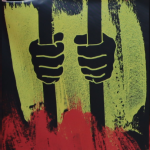PM’s Retrograde Domestic Violence Counselling: An Interview with WDVCAS’ Hayley Foster

Early last month, it came to light that the Morrison government has put aside $10 million to fund Specialised Family Violence Services, which is essentially a program that involves the provision of counselling and dispute resolution for couples dealing with domestic violence.
Those working at the frontline in the domestic and family violence sector collectively shook their heads in disbelief, as they realised the government is proposing to lead women seeking help from violence into a situation that’s likely to heighten their problems.
Couples counselling might work when partners on an equal footing want to resolve their disagreements, but it’s not a recommended way to resolve a situation where one partner is physically attacking the other and taking advantage of a society-wide power imbalance.
Close to half of the organisations invited to apply to deliver the counselling are faith-based, and the majority of those are Catholic. And questions have been raised as to whether the Pentecostal PM’s religious views are once again influencing government policy.
Behind closed doors
Domestic and family violence is in many ways the unspoken crisis gripping the Australian suburbs. On average, one woman a week is murdered by a current or former partner, while one in three Australian women over the age of 15 have experience physical violence.
In 2016, it was estimated that Australian police deal with around 5,000 domestic violence matters every week, which is one every two minutes. And it’s well-recognised that the primary driver behind this epidemic is gender inequality.
So, what Morrison and his lot are suggesting is that a woman sit down with her abuser, listen to his reasons for not being able to control himself, share how she’s feeling and then head home alone with him to face the very real prospect of retribution over what transpired during the session.
Ballot box considerations
The $10 million set aside for the couple’s counselling is part of a $328 million funding package the Coalition has earmarked for the National Plan to Reduce Violence Against Women and Their Children 2010-22, which is a strategy that’s been noted for underdelivering.
While last week, the Labor Party announced it would be doubling the government’s commitment to ending domestic and family violence with a $660 million package, which will include funding refuges and accommodation, legal assistance, safe housing and frontline services.
With 15 years’ experience in the sector, Hayley Foster asserts that the Morrison government’s couple’s counselling is a dangerous proposal. And the director of the Women’s Domestic Violence Court Advocacy Service (WDVCAS) NSW adds that if delivered upon, Labor’s proposal has promise.
Sydney Criminal Lawyers spoke with Ms Foster about the reasons why the sector is up in arms about couples’ counselling, what the best practice strategy experts recommend as an alternative is, and how the NSW government has been “making a real difference on the ground”.
Firstly, the Morrison government has set aside $10 million to fund a counselling service for couples dealing with domestic violence. Ms Foster, what is it about this type of counselling that’s so detrimental?
Couples counselling in the context of domestic and family violence can be quite a dangerous service system intervention. The very premise of couples counselling is you are providing a safe space where couples can come together to mutually resolve issues which are arising in relationships.
But, in the case of domestic and family violence, we’ve long moved past the position that those who have experienced the violence and abuse – who are usually women – have done something to cause that conduct and that they need to take mutual responsibility for resolving it.
In fact, this kind of intervention can be extremely counterproductive. We know from our experience with family and domestic violence perpetrators that they tend to place a great deal of responsibility for their behaviour on the object of their abuse: the victim.
And victims themselves come to doubt their own judgement and begin to blame themselves for what’s happening to them.
So, this only increases the level of power and control in the relationship that the perpetrator has over the victim, which can increase the risk and also put greater barriers in front of victims, when they’re trying to access the appropriate supports.
There are real dangers in providing a forum where victims of violence are encouraged to talk about aspects of their relationship in what they are led to believe is a safe place.
Women might make disclosures thinking it’s safe and it can result in retribution from the perpetrator. In many cases, we’ve seen women experiencing retribution. And it might be for what they’ve said or the way they appear. It might be they’ve said too much, or they didn’t say enough.
We’ve heard of countless experiences with women either being pressured into counselling or they’ve agreed to it, but they’ve experienced retribution as a result, pretty much as soon as they leave the counselling or when they get home.
A lot of the organisations that have been invited to provide this counselling are faith-based. Would you say this strategy has been shaped by religious values?
WDVCAS NSW are concerned that the federal government has disregarded our advice in regard to these programs. But, we’re not really in the position to say whether it has actually been shaped by religious values.
Though we do question the motivations of such a program, which does go against the expert advice, and has the potential to further compound the imbalance of power accompanying domestically violent relationships and leave victims with a reduced ability to reach out for support.
I can’t comment on why, but we would like an explanation as to what the motivations are.
For couples that are dealing with domestic violence issues, what do those working in the sector dealing with actual cases recommend?
One of the misconceptions about specialist family and domestic violence services is that we actually push women into separating. But, that’s not actually true.
We recognise that not all victims of violence can, or indeed, want to leave the relationship. They just want the violence and abuse to stop in most cases.
We work with women who just want it to stop and don’t want to leave and then, we work with other women, who are extremely fearful for their lives and their children’s. There’s a spectrum.
But, best practice in working with couples in the context of domestic violence is a safety first approach, which means doing anything possible to ensure the interventions don’t actually increase the risks of harm for the victims.
So, again, we’re pretty much off to a really poor start with this government proposed counselling intervention. Because the capacity to increase the risk of harm is so high.
In terms of best practice, what this looks like will vary. But, the common scenario would involve the male accessing a behaviour change service that specialises in working with men who use violence. And the woman would access a specialist domestic and family violence service.
The best practice would involve the men’s behaviour change working with the partner either through a women’s specialist service or through a separate partner support program. They will work with a safe mechanism so the partner can provide feedback on how things are going.
Men’s behaviour change programs will use a variation of individual and group interventions, depending on the different situations and the level of risk.
Then the partner of that male will be engaged in a women’s support service, which will provide a safe mechanism for that partner to provide feedback. That can be carefully considered as part of the overarching intervention provided to the perpetrator, but not in a way that puts her at risk.
It’s a highly specialised field and it’s certainly not one where you have a whole-of-family approach and you can just provide counselling without the rigour that’s attached to a specialist model.
Crucially, engagement with key government agencies – such as police, FACS and Corrective Services – is maintained. And this is the requirement of service entry into these programs.
So, men’s behaviour change services assist men to understand the implications of various civil and family law orders. And women are supported with their engagement in the justice system, where there are personal and police initiated civil and criminal law proceedings.
The funding for the counselling is part of the money earmarked for the National Plan to Reduce Violence Against Women and Their Children. This year marks the beginning of the fourth part of this plan.
In your opinion, how adequate have the previous three action plans been in what they’ve proposed to deliver?
We were all really excited about the 2009 Time for Action report. It was highly celebrated as a blueprint for reform. It was developed through extended consultation and provided clear vision over a range of areas.
But, when you compare that to the performance of the National Plan, it’s fair to say that whilst there has been significant gains, we have not come anywhere near as far as we would have liked to have seen after three action plans.
As we head into advising on the Fourth Action Plan, we’re actually just trying to set our sights on the next ten year action plan.
And the key learning out of that is that it’s fallen in two areas. One is that there’s not really been the funding required that we were hoping to see. The reality is we’re still turning women and children away from vital services that they need to escape violence.
Secondly, the other areas where we’ve fallen down is collaboration with the experts. It was great when we developed the plan. But, then it fell down when it came to policy design and implementation.
The $10 million that we just heard announced for the couples’ counselling and mediation is a very clear example of how the plan didn’t translate into practice and policy.
The Labor Party has announced that, if elected, it will be providing a $660 million family and domestic violence package. What sort of difference would a change in government bring to the domestic violence crisis?
There’s no doubt that federal Labor has been doing a lot more listening when it comes to domestic violence policy.
Aside from the increase in investment that we’re seeing – the doubling in dollars – the key difference between the two platforms is that Labor has invested more significantly in frontline specialist domestic violence services, and in primary prevention at the local level.
The reality is that a number of these announcements from Labor have the potential to significantly increase safety, reduce risk and actually bring about cultural change to drive down the rates of violence against women.
But, the key to affecting this really is in the co-design process. The National Plan fell down when they didn’t co-design the policy and its implementation.
The other thing that’s going to be essential is service integration. There’s no point in developing a whole lot of new services that don’t really complement the service systems that already exist in the state and territories. So, we need a really good design process and then we should see a big impact
At the state level, the Baird government implemented the Going Home Staying Home
reforms in 2014. This homelessness strategy has been much criticised for its impact on services for women experiencing domestic violence.
Five years on, what’s the situation like today for women trying to leave domestic violence situations in this state?
It’s true Going Home Staying Home had significant ramifications for the domestic violence sector. And I would say for the women’s movement more generally.
What we have seen with Going Home Staying Home was in no uncertain terms a decimation of the women’s refugee movement, and generations of practice wisdom went with it.
This is the same practice wisdom that we still rely upon today in the Women’s Domestic Violence Court Advocacy Service. But, in the specialist accommodation services certainly it was quite a gutting.
I was a child of the women’s refugee movement. So, it was quite devastating to see a lot of my mentors and their services being unceremoniously dumped.
A lot of lessons were learnt from the Going Home Staying Home reforms. There had been some underestimation of the importance of women’s specialist domestic violence services before its implementation.
And this certainly became apparent quickly thereafter as the government and the domestic violence policy had to contend with a new work force and service cultures that weren’t really best equipped for the task.
You’re the director of the NSW Women’s Domestic Violence Court Advocacy Service NSW. Can you tell us about the work your organisation does?
The Women’s Domestic Violence Court Advocacy Service NSW is the peak body that represents the 29 WDV court advocacy services statewide. These provide the primary specialist assistance to women who’ve experienced domestic violence in NSW.
We advocate on systemic issues impacting on women and children, who have experienced domestic and family violence, through legislative policy, practice and law reform.
And lastly, Ms Foster, often the family and domestic violence funding packages that are delivered by government sound good, but don’t seem to make a difference on the ground in areas where it’s needed most.
Where should government funding be focused in order to bring about meaningful change?
Going Home Staying Home went out to tender in 2014. But, around the same time in 2013, the government began implementing its Domestic Violence Justice Strategy and in 2014, the It Stops Here Safer Pathway reform.
Unlike Going Home Staying Home, these other reforms centred around an approach which held specialist women’s agencies at their centre.
And these women’s agencies – which are the court advocacy services that we represent – offer services to women who have experienced violence in locations across NSW in a fully integrated way with frontline government agencies and non-government agencies.
And there are a lot of other things that the government has gotten right since then too. So, we’ve expanded the Staying Home Leaving Violence program to 23 locations across the state.
These are the kind of things that are making a real difference on the ground. These are things that we want to see more investment in.
Family violence services can support women and children to remain safely in their home, where it is safe and desirable to do so, or to transition to a more suitable property. And the other key services that make a real difference are the legal and women’s health services.
So, when we are talking about Going Home Staying Home and it comes to accommodation the reality is post that reform there are still gaps and issues.
And we did a current survey for support accommodation across NSW, and while across the state about 90 percent of our workers say there are referral options in their area, 73 percent report that there really are significant issues in finding places for women and children.
It’s really good to see some announcements in that space from both sides of the government. And obviously, the larger commitments from the Labor Party. And we think that those sorts of things will make a really big difference.
When it comes to getting it right in the future, sector co-design is essential to get it to where it’s needed most. We need to listen to the sector around those areas of priority, because we’re the ones who are seeing women day in, day out. We know where there are crucial gaps.
But, for us, when we surveyed our members across NSW, the biggest service gaps that we identified were case management – ongoing support for victims post-crisis – specialist accommodation services was next, then financial assistance, then specialist counselling and then specialist legal advice.
In the federal announcements, both the Coalition and Labor have announced commitments in the specialist accommodation space. And Labor made announcements in all the other areas, except for the key gap, which is case management.
So, we would say that case management – the ongoing support, so they don’t get passed from service to service, and they can access legal services, be supported through the court process and access social services – is the key gap.
And that’s where you’re going to get the biggest bang for your buck.







